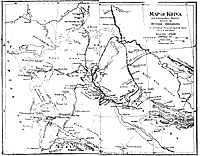 MacGahan, J A. Campaigning on the Oxus, and the Fall of Khiva. Harper & Brothers, 1874. reprinted by Arno Press, 1970.
MacGahan, J A. Campaigning on the Oxus, and the Fall of Khiva. Harper & Brothers, 1874. reprinted by Arno Press, 1970.
It is 1873 the Russians have sent five columns towards Khiva to capture it. MacGahan joins the column from Kazala after having crossed the Kara Kum desert in winter.
Jumbo Map (extremely slow: 560K)
The following are quotes from the above book that give an idea of the Russian forts, flotilla, the make up of General Kaufmann's column from Tashkent and the typical garrison left behind.
Page 15
"Kazala, or Fort No. 1, was the entering wedge of the Russians into Central Asia.... The Capture in 1853 of Ak-mesdjid, 250 miles farther up the river-now called Fort Perovsky (Fort No. 2)-assured the safety of the Russian position on the Syr (Darya).
The fort (No. 2), a small earthwork about 200 yards square, surrounded by a ditch, defended by a few light pieces of cannon, and garrisoned by about 1000 men, is a fair specimen of all the Russian forts in this part of the world...in Central Asia, with such fortresses, the Russians hold an empire in subjection. Between it and the river is the navy yard, and on the land side has sprung up the flourishing town of Kazala, which numbers about 5000 inhabitants."
Page 17
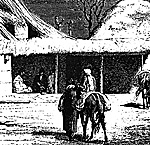 "One of the first things that attracted our attention was the Aral (Sea) flotilla. There were three good-sized side-wheel steamers, the 'Samarcand,' 'Perovsky,' and 'Tashkent'; two stern-wheelers, the 'Aral' and 'Syr Darya'; a steam-launch, the 'Obruchef,' and many barges, of which three were schooner-rigged. We saw, besides, two new barges, one of which had just been launched, while the other was still on the stocks.
"One of the first things that attracted our attention was the Aral (Sea) flotilla. There were three good-sized side-wheel steamers, the 'Samarcand,' 'Perovsky,' and 'Tashkent'; two stern-wheelers, the 'Aral' and 'Syr Darya'; a steam-launch, the 'Obruchef,' and many barges, of which three were schooner-rigged. We saw, besides, two new barges, one of which had just been launched, while the other was still on the stocks.
Two or three of these vessels were built in Sweden, but the rest were all constructed in Liverpool or London. They are all of iron, and were brought here in pieces, and put together...The 'Samarcand,' which was built, I believe, in 1870, is by far the best of the fleet, and is an exceedingly pretty and comfortasble craft. They are none of them well fitted for the shallows of the Syr-Darya, as they draw too much water to run on the river, except in the high water of spring and midsummer, when the snow melts in the mountain ranges. Here the Syr-Darya is deep enough; but near Fort No. 2 there are many shallows, which are constantly changing."
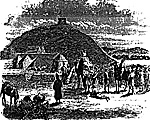 Page 163
Page 163
"General Kaufmann's march from Tashkent.
"His force was composed of eleven companies of infantry, 1650 men, one company of sappers and miners, half a battery, or four pieces of horse artillery, six pieces of foot artillery, breech-loading, all of the newest models; half a battery of mountain pieces, a battery and a half of rockets, and 600 Cossacks; in all about 2500 men. This detachment left Tashkent on the 15th of March.
"The train was composed of between 3000 and 4000 camels hired from the Kirghiz at the rate of twelve rubles per month, with the proviso that each camel dying on the way should be paid for at the rate of fifty rubles apiece. The whole force was united at Djizzak by the 25th of March, which place the head of the column left on the same day."
Page 164-165
"The Kazala column,...was composed of eight companies of infantry, half a battery of mountain pieces, half a battery of rockets, two mitrailleurs, and 150 Cossacks, in all about 1400 men. They set out from Kazala, or Fort No. 1, on the 11th of March, and were to meet the column from Tashkent at Bukali, in the Bukan-Tau mountains, 120 miles from the Oxus. They had reached this point, when they received the order to join the other detachment at Khala-ata.
"This change of route appears to me to have been a great mistake. Although for the Tashkent detachment, the way by Khala-ata was the shortest and best, it was quite otherwise for the Kazala column. At Bukali they were within 120 miles of the river. It was the middle of April; the weather was still cool, and there being several wells they would besides have been obliged to carry water only half that distance. The river might thus have been reached in ten days, just one month sooner than they actually did reach it. Instead of this, however, they had, in carrying out Kaufmann's order, to make a retrograde movement, which required two weeks, and at the end of that time they were no nearer the river than before. The same time was consumed by Kaufmann in waiting for them. And the time thus lost was the most favorable for marching, as the weather was still cool, and the fierce heat which afterwards assailed them had not yet come on."
The two column march toward the Oxus crossing more of the Kyzil Kum desert and reach Alty-Kuduk or Six Wells but the water is bad and the men "exposed to the broiling heat of a desert sun, on a pint of water a day..."
Page 169-170
"In the mean time, as there was no water for the camels, Kaufmann sent the whole train back to Adam-Kurulgan, to let them drink, and then to get a fresh supply of water before making another attempt to proceed. The camels were sent with an escort of four companies, or 600 men. It was against this escort that the troops of the Khan made their first serious attack.. "Sadyk...understood very well that if he could capture the camels, the army was beaten, and would have to retreat. He took 500 Turcomans, each provided with two horses, and passing Kaufmann at Alty-Kuduk, reached Adam-Kurulgan early on the morning of the 18th of May.
"It was about four o'clock in the morning when the Russian pickets were driven in, and the alarm was given. By the time the troops had seized their arms, the Turcomans were very near the camp. The attack was conducted with considerable spirit and vigour. The Khivan standard was born by Sadyk himself, who rode a splendid white horse, and he advanced so near, that if any of the sharpshooters had known it was Sadyk they would certainly have picked him off. But what can men, undisciplined, and armed only with sabres, however brave individually, do against breechloaders?
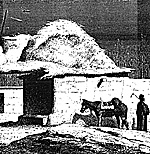 Soon perceiving the impossibility of advancing in face of the superior arms of the Russians, the Khivans finally retreated, completely discomfited. Sadyk, as appears from the reports of the prisoners taken, had been confident of a complete victory, having been misinformed as to the real number of troops he would have to deal with, and supposing he would only find a mere handful of men. This was the first serious encounter the Khivans had with the Russians. They were very much discouraged by it, although still not without hopes that Kaufmann would be unable to reach the river.
Soon perceiving the impossibility of advancing in face of the superior arms of the Russians, the Khivans finally retreated, completely discomfited. Sadyk, as appears from the reports of the prisoners taken, had been confident of a complete victory, having been misinformed as to the real number of troops he would have to deal with, and supposing he would only find a mere handful of men. This was the first serious encounter the Khivans had with the Russians. They were very much discouraged by it, although still not without hopes that Kaufmann would be unable to reach the river.
Kaufmann finally determines that he cannot continue with the camels as they can barely carry 200 at most. He reluctantly leaves them behind at Alty-Kuduk with, two companies to protect the baggage, two pieces of artillery and four of the six collapsible boats for crossing the Oxus. Once the Oxus was reached and the crossing begun the remaining camels were sent for.
I am not sure who makes Russo-Turkish War figures. But uniforms can be copied from the Osprey #277 The Russo-Turkish War 1877, plate A- 1, 2 &3; plate B - 3; plate C- 3 and for the Cossacks use the Orenburg and Don Cossacks from the chart last issue or the chart in Osprey #277.
Bibliography
The following is a beginning bibliography for the North-West Frontier and the Great Game. Kipling's Kim will provide numerous scenario beginnings for 1:1 skirmishes. While most of the following will provide for larger scale actions up to corps level.
Barthorp, Michael. The North-West Frontier: British India and Afghanistan, A Pictorial History 1839-1947 . Poole: New Orchard Edition, 1982.
Bilgrami, Asghar H. Afghanistan and British India 1793-1907; A Study in Foreign Relations. New Delhi: Sterling Publishers, Ltd., 1972.
Curzon, George N., M.P. Russia in Central Asia in 1889 and the Anglo-Russian Question. London: Longmans, Green, and Co., 1889.
Elliott, Major-General J. G. The Frontier 1839-1947; The Story of the North-West Frontier. London: Cassell & Company, Ltd., 1968.
Hobkirk, Peter. The Great Game. Oxford: Oxford University Press, 1991.
Maxwell, Robert. Villiers-Stuart on the Frontier 1894-1914. Edinburgh: Pentland Press,1989.
Menning, Bruce W. Bayonets Before Bullets; The Imperial Russian Army, 1861-1914. Bloomington: Indiana University Press, 1992.
Morgan, Gerald. Anglo-Russian Rivalry in Central Asia: 1810-1895. London: Frank Cass and Company, Ltd., 1981.
Nevill, Capt. H. L. Campaigns on the North-West Frontier. Dehli: Neeraj Publishing House, 1912.
Richards, D. S. The Savage Frontier; A History of the Anglo-Afghan Wars. London, Macmillan, 1990.
Younghusband, G. J. Indian Frontier Warfare. Dehli: Anmol Publications, 1985 reprint.
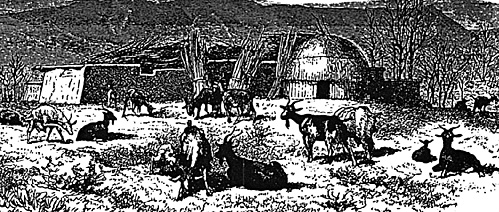
Back to The Heliograph #102 Table of Contents
Back to The Heliograph List of Issues
Back to Master Magazine List
© Copyright 1997 by Richard Brooks.
This article appears in MagWeb (Magazine Web) on the Internet World Wide Web.
Other military history articles and gaming articles are available at http://www.magweb.com